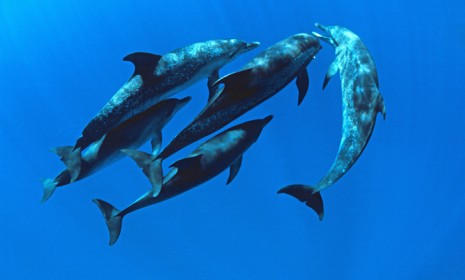Are dolphins the gangsters of the sea?
The playful mammals can actually be quite conniving, forming Mafia-like gangs to protect their own

The whip-smart bottlenose dolphin continues to surprise scientists with its intelligence, with new research suggesting that the brainy marine mammals form intricate, gang-like groups to protect their herd and attack rivals. Here's what you should know about the ocean's secret mobsters:
How was this research conducted?
A team from the University of Massachusetts, Dartmouth, spent more than six years observing roughly 120 dolphins in Shark Bay, an eight-square-mile area off the coast of western Australia. Dr. Richard Connor, who led the team, first began studying the bay's dolphins in the 1980s, and is now seeking to chart the mammal's "complex social relationships" by observing how different groups act when they encounter each other.
The Week
Escape your echo chamber. Get the facts behind the news, plus analysis from multiple perspectives.

Sign up for The Week's Free Newsletters
From our morning news briefing to a weekly Good News Newsletter, get the best of The Week delivered directly to your inbox.
From our morning news briefing to a weekly Good News Newsletter, get the best of The Week delivered directly to your inbox.
What did scientists discover?
Shark Bay's dolphins don't occupy specific territories, instead living in a "mosaic of overlapping ranges," says Dr. Connor. That forces the dolphins to form clearly defined pods that become part of a larger network of relationships. Researchers discovered that male dolphins often engage in "extensive bisexuality, combined with periods of exclusive homosexuality" to build relationships in these groups, says Discover News. From there, the pods form three different levels of alliances.
What kinds of alliances do the dolphins form?
The "first-order alliance" consists of tight-knit pairs or trios of male bottlenose dolphins who guard the group's females for mating. "These consortships can last over a month," says Dr. Connor. These same dolphins go on to form a "second-order alliance," recruiting between four and 14 other males to attack other pods, steal other gangs' females, and defend against attacks. The third and final level is a group charged with "friendly relations," acting as liaisons to form even larger dolphin armies.
A free daily email with the biggest news stories of the day – and the best features from TheWeek.com
Why do they form these gangs?
It's mostly because of "one simple, unexpected factor," says Virginia Morell at Wired: The dolphins' slow cruising speeds and the consequential likelihood that they're going to cross paths with each other. Says Dr. Connors: "If you're going to run into your enemies, you better be with your friends, or have some that are close by, willing to be recruited.
Do any other animals do this?
Humans do. Indeed, dolphins' tangled social webs are reminiscent of a soap opera, says Morell, with the dolphins keeping track of who's an enemy, who's a friend, and who might potentially be ally. But besides people and dolphins, such "intricate webs" are exceptionally rare in the animal kingdom, says Morell, and sound like "the Mafia" more than anything.
Sources: ABC News, BBC News, Discover News, Jezebel, Wired
-
 Russia’s ‘weird’ campaign to boost its birth rate
Russia’s ‘weird’ campaign to boost its birth rateUnder the Radar Demographic crisis spurs lawmakers to take increasingly desperate measures
-
 Could smaller cars bring down vehicle prices?
Could smaller cars bring down vehicle prices?Today’s Big Question Trump seems to think so, but experts aren’t so sure
-
 2025’s most notable new albums
2025’s most notable new albumsThe Week Recommends These were some of the finest releases of the past year